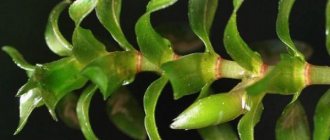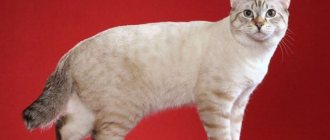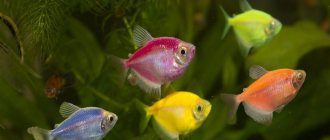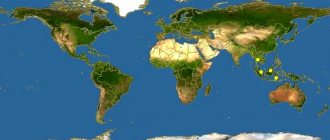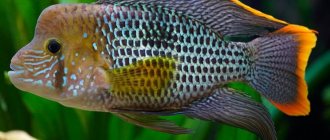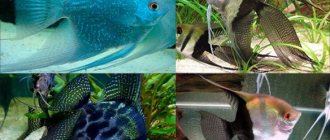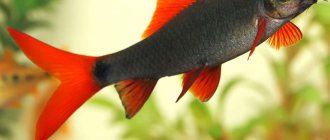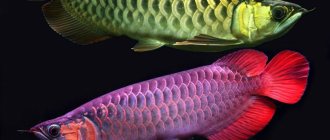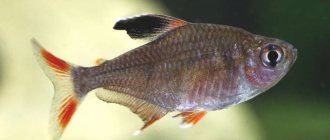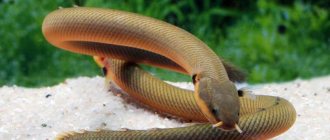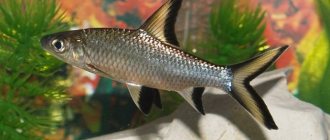Description
Popular for its unusual appearance, different from the usual Goldfish. The oval body, expanded on the sides, looks like an egg. They grow on average up to 15–20 cm. Of particular value is the bright red wen that covers the top of the head and ends at eye level. When breeding fish, individuals with the largest caps were selected. Until now, the fish that has a larger head with a red wen is considered more valuable. Such representatives are valued at much higher prices.
The color of all representatives is the same - the body is white-pinkish in color with metallic tints. Representatives of other colors are less common.
The fins are translucent and whitish in color. The fish have genes for the veil tail, from which the red cap got a long veil-like tail, often exceeding the length of the body. Individuals with a caudal fin in the form of a skirt are especially valued.
Types of oranda:
- Black oranda. The body color is charcoal black, with gold inclusions.
- Blue oranda. Gray or blue colors.
- Calico oranda. The main color is pale golden-red with chaotic spots of different colors.
- Chocolate oranda. Body color is brown-chocolate.
Behavior
The red cap aquarium fish is a peaceful inhabitant of the aquarium, rarely getting into skirmishes or fights with other residents. Most often, representatives treat others neutrally, not noticing other species. But it loves to swim in the company of its own kind, so it is advisable to keep it in a small flock.
Lifespan
The average lifespan of this aquarium fish is 13-16 years. One record holder lived for more than 40 years.
Little Red Riding Hood Fish
The red cap fish appeared as a result of artificial cultivation of a breed of goldfish.
The ornamental fish was first bred in Japan. The breed is distinguished by its picturesque appearance and head decoration in the form of a red cap, which is how the aquarium fish got its name. Little Red Riding Hood
Appearance
The redcap is a type of freshwater crucian carp, usually white in color and has a characteristic growth on its head. The body has an elongated shape that contracts at the sides. Goldfish can reach an impressive size of up to 22 cm.
Aquarium inhabitants look very attractive. The cap has a single dorsal fin. Other fins have a pair. The tail has a characteristic shape and length, which accounts for approximately 50% of the total body length.
Conditions of detention
Little Red Riding Hood is a rather capricious resident of the aquarium. Acceptable temperatures are between 18 and 23 degrees. If it deviates from the set temperature, the goldfish dies.
Aquarium inhabitants are very large in size, so the volume of the aquarium is calculated as 100 liters per individual. It is recommended to keep this breed in pairs.
The soil of the aquarium should be of medium size. It is advisable to avoid varieties with sharp edges, as aquarium inhabitants love to dig in it and can get hurt.
Little Red Riding Hood needs constant water filtration. The aquarium must contain plants and driftwood that create decor. This environment enriches the entire aquarium with oxygen and significantly reduces nitrate levels.
Water parameters must meet the following requirements: Hardness from 6 - 18°dGH, pH - 5.0 - 7.0. It is recommended to partially replace the water by 20-30% every week.
Compatibility
Aquarium inhabitants have a very peaceful character. Overly active and aggressive breeds should not be added to them. Size doesn't matter. Little Red Riding Hood will be absolutely defenseless even in front of a fish half her size.
Little Red Riding Hood
It is worth noting that the breed poses a threat to aquarium plants. Goldfish love to eat vegetation, so you should be prepared to frequently replace your aquarium fauna.
What diseases is the breed susceptible to?
Diseases of the breed are conventionally divided into contagious and non-contagious. The last group includes the following:
- poor nutrition;
- alkalosis;
- oxygen deficiency diseases;
- stress diseases.
Infectious diseases pose a danger to all inhabitants of the aquarium and are expressed in the following types:
- tuberculosis;
- smallpox;
- rubella.
Feeding
Aquarium fish always look hungry and are capable of eating huge amounts of food. It is necessary to feed them carefully, twice a day, in medium portions.
Goldfish require a rich and varied diet. All types of feed are welcome. It is recommended to buy live varieties only frozen. Plant foods in the form of cabbage and cucumber are very beneficial for the breed.
Breeding
Representatives of the species are capable of having offspring at the age of 2 years. Reproduction occurs in early spring. To create favorable conditions, it is necessary to provide warmer water temperatures and diffused light.
Before spawning, it is recommended to place males and females in different aquariums for a couple of days and feed them exclusively with live food. After spawning, the fish must be reared again, as the parents can eat their own eggs. The fry will appear within 5 days. Live food is preferred.
aquarists.ru>
Content
Goldfish have a stigma of being messy. But this is not true, they pollute the aquarium no more than other species and need infrequent cleaning 1-3 times a month. And this myth arose due to the large amount of food consumed.
Caring for the little red cap fish includes weekly replacement of 1/3 of the volume of water in the aquarium.
Aquarium
The size of the aquarium for one Goldfish is 50 liters. For a small flock of several representatives, you will need an aquarium of more than 100–150 liters. The number of decorations should be minimal. Sand and decorative items are also selected taking into account the remaining free space for swimming. Large volume is much more important than cover.
Water parameters
Comfortable temperature is 16–25 degrees. Acidity should not exceed 8 pH and be not lower than 5 pH. Water hardness 6–18 gH.
Plants
They are partial to live plants in the aquarium. Often the leaves are bitten off, and the roots are dug up and gnawed. For tanks with red caps, rigid-leaved plants with a strong root system or artificial vegetation are suitable.
Suitable plants:
- Anubias.
- Aponogeton rigidifolia.
- Congo fern.
- Microsporium or Thai fern.
- Echinodorus.
- Crinum calamistratum.
- Cyperus Helfera.
- Lagenander Meebold.
Priming
Oranda is distinguished by its love of digging. To avoid unnecessary pollution of the aquarium, choose river sand or crushed gravel or pebbles as a substrate. Avoid large stones with sharp edges.
Equipment
The aquarium is equipped with an aeration device and a filter.
Install a powerful compressor, because red caps are especially sensitive to the amount of oxygen in the water. A filter will help keep the aquarium clean and remove excess organic matter.
Lighting
Goldfish love direct sunlight and bright artificial lighting. In prolonged dim light their color fades.
Compatibility with other fish
Like other goldfish, oranda is a cold-water animal, and therefore its neighbors should live in low temperatures without problems. It is best to keep them in a species aquarium with other short-bodied varieties of goldfish, such as telescopes, veiltails, pearls, ryukins, etc.
From representatives of other families, you can choose Corydoras and Botsia catfish, but you need to remember that the latter can be too active, especially if you do not provide them with enough shelter.
Keeping red caps with tropical fish is possible, but not everyone will be comfortable with such a union. First of all, you need to provide the animals with a sufficient amount of space and equip the container with a powerful filtration system, since goldfish greatly stain the water.
Before choosing a neighbor, you need to make sure that he is not prone to plucking fins. Cocky fish such as barbs and cichlids should be avoided. But the goldfish themselves are far from harmless little creatures, and if they see a slow-moving cockerel with long fins, they will gladly try to taste them.
Feeding
Oranda red cap is unpretentious in its choice of food; it eats live, plant, dried and frozen food. But a significant part of the food should still consist of vegetation.
These aquarium fish have a high appetite. Develop a feeding plan in advance and stick to it daily. Feed fry and juveniles twice a day, reduce the diet of adults to 1 feeding per day.
If you do not adhere to the diet, then the fish will show a symptom of overeating - it begins to swim on its side. If you overeat, reduce the dose of food and arrange a fasting day.
Specialized industrial food for Goldfish also eats well.
Diet and feeding order
The red cap oranda is gluttonous. This increases the likelihood of the fish developing obesity, so they are fed several times a day, but only a little at a time. The daily food intake by weight should not exceed 3% of the body weight of the fish itself.
Plant-based foods (chopped lettuce or spinach) are the best option for oranda. But her menu also includes live and dry food to make it balanced.
An overfed little red riding hood floats with its side up. If this happens frequently, then the fish may be suffering from an intestinal disease.
We recommend reading
Aquarium butterfly fish
Compatibility
The red cap goldfish is a peaceful and schooling species. Therefore, it is well compatible with all representatives of Goldfish, calm or neutral species that do not pay attention to goldfish.
View this post on Instagram
Posted by Aquarium and Pet Supplies (@_kamidog_) Feb 21, 2018 at 4:39 PST
Compatible Types:
- Danio Rerio.
- Shubunkin.
- Guppy.
- Telescope.
- Comet.
- All types of catfish.
- Ternetia.
- Cardinal.
Low compatibility with large and territorial fish that show aggression. I still can’t stand being in the vicinity of nimble and active fish, which will bully calm red caps and spoil and tear off long fins. Too miniature species are also not suitable - they will be quickly eaten.
Incompatible types:
- Barbus.
- Discus.
- Sword bearer.
- Cockerels.
- Neons.
- Mollies.
- Fry of small fish species.
Behavior and compatibility with neighbors
Red Riding Hoods prefer to gather in groups and, when in the company of their relatives, behave calmly. Orandas are characterized by slowness and clumsiness, which does not allow them to defend themselves even from small and relatively weak fish. Therefore, it is recommended to place them in a separate species aquarium. If this is not possible, then you need to be extremely careful in choosing neighbors for the red riding hoods.
Oranda is non-conflicting and when placing it in a common tank, you should make sure that there will be equally peace-loving fish next to it:
- speckled catfish;
- zebrafish;
- guppies and the like.
We recommend reading:
What to feed your betta fish
More aggressive neighbors, even if they are not predators, pluck the fins of red caps and cause other injuries.
Reproduction
Representatives become sexually mature and capable of reproduction at 1.5–2 years of age. For procreation, a female and 2–4 males are selected. If you want to get valuable and expensive fry, then choose from the flock representatives with the largest caps and long tails. If the fry are not for sale and will remain in the aquarium, then any representatives are suitable.
Set up a separate spawning area and move selected individuals into it.
Differences between a female and a male
Sexual dimorphism is weak; sex determination is difficult. Typically, males are smaller in size, and their bodies are more graceful and elongated. Females are larger and more massive. Before spawning, the color of males becomes brighter and white spots appear on the head.
Spawning
Food portions increase before spawning, and a variety of foods are introduced into the diet. To stimulate the spawning tank, lower the temperature by a couple of degrees.
Most often, the female begins to spawn in the morning at dusk. The spawning process lasts 2–4 hours. The eggs are laid on the leaves of planted plants. After spawning, the parents are placed in a common aquarium because they are able to eat the eggs.
Inspect the eggs and remove the whitish eggs. The eggs hatch into larvae after half a week.
Care of offspring
After another half a week, the larvae turn into active fry, learning about the world around them. The babies' diet consists of live dust, crushed daphnia or special food for fry. After a few weeks, the fry will get stronger and begin to look like miniature copies of adult fish. At this age they are transplanted into a common aquarium.
Reviews
The opinions of aquarists who bought red cap aquarium fish vary. Although initially the beauty and calm disposition win the hearts of buyers, later problems arise in caring for the red cap fish. Novice aquarists who have overestimated their strengths complain about the difficulties of keeping a pet. The main reason for difficult care is the large amount of released organic matter. And if the aquarium is not properly cleaned, mold, brown algae appear, and the water becomes cloudy.
Price
The cost depends on their age and size. The value increases depending on the size of the red wen on the head and the length of the caudal fin.
| Size, cm | Cost, rubles |
| Fry, 1–2 | 100 |
| Grown-up fry, 2–5 | 200 |
| Teens, 6–8 | 250 |
| Adults, 9–15 | 350 |
| Large representatives, 15–20 | 400–500 |
Photo gallery
Previous
FishContent of the cocky minor (serpas)
Next
FishStep-by-step instructions for breeding zebrafish in an aquarium
